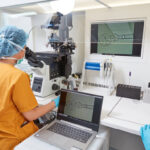Eksozom Nedir?
Eksozomlar, hücrelerin birbirleriyle haberleşmesini sağlayan mikroskobik keseciklerdir. Vücudun farklı organ ve dokuları, ihtiyaç duydukları sinyalleri iletmek için bu kesecikleri kullanır. Eksozomların içinde:
• Hücre yenilenmesini ve onarımını destekleyen biyoaktif maddeler,
• Hücrelerin işleyişini düzenleyen microRNA’lar,
• Gerekli protein ve hormonların üretimini uyaran yapılar bulunur.
En etkili eksozomlar, kök hücrelerden elde edilenlerdir. Özellikle mezenkimal kök hücre, kemik iliği, kordon kanı ve plasentadan elde edilen eksozomlar; doku yenilenmesi, hücre çoğalması, damar oluşumu ve yara iyileşmesi gibi süreçleri destekler.
Kadın İnfertilitesinde Eksozomun Rolü
Bilimsel çalışmalar eksozomların kadın üreme sağlığında önemli etkiler gösterebileceğini ortaya koymuştur:
• Yumurta olgunlaşmasını ve yumurtayı besleyen hücrelerin ömrünü uzatır.
• Östrojen sentezini artırır, yumurtlamayı kolaylaştırır.
• Yumurtalıkta gizli bekleyen yumurtaların büyümesini destekler.
• Embriyo oluşumunu ve rahme tutunmasını kolaylaştırır.
• İnce endometriyumlarda kalınlaşmayı sağlayarak rahim iç zarını iyileştirir.
Ayrıca erkeklerde de spermin olumsuz faktörlerden korunmasına ve ereksiyon fonksiyonunun desteklenmesine yardımcı olabilir.
Eksozomun Güvenliği ve Yan Etkileri
Eksozomlar, kök hücrelerde olduğu gibi alıcı-verici uyumu gerektirmez. Araştırmalara göre:
• Alerjik reaksiyon yapmazlar,
• Tümör oluşturmazlar,
• İltihaplı bölgelere doğrudan uygulanabilirler.
Bugüne kadar ciddi bir yan etki bildirilmemiştir.
Eksozom Nasıl Uygulanır?
Eksozomlar farklı yollarla vücuda verilebilir:
• Cilde sürülerek veya cilt altına enjekte edilerek,
• Burun spreyi ya da göz damlası şeklinde,
• Solunum yolu ile,
• Kadınlarda: yumurtalık içine veya rahim zarına enjeksiyonla,
• Gerektiğinde laparoskopik yöntemlerle.
Özellikle yumurtalık rezervi düşük veya rahim içi hasarı olan kadınlarda, ultrason eşliğinde anestezi altında yapılan enjeksiyonlarla uygulanmaktadır.
Sonuç
Eksozom tedavisi, tüp bebek alanında umut verici ve yenilikçi bir yaklaşımdır. Ancak uygulamanın mutlaka deneyimli hekimler tarafından yapılması ve her hastada kişiselleştirilmiş planlama ile değerlendirilmesi gerekir.





